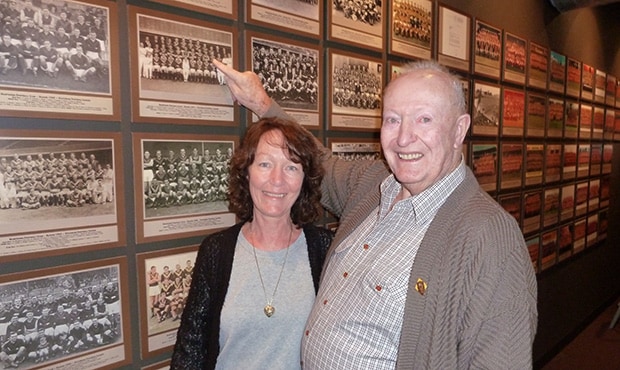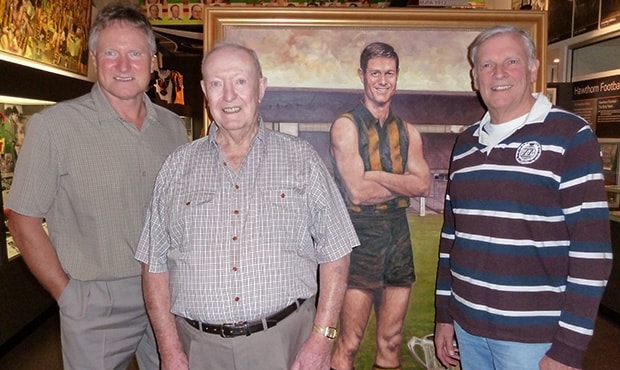The Hawks Museum recently played host to two families with long associations with the Club that dates back to the days when Hawthorn played in the Victorian Football Association.
Former player Kevin Hevey as part of his 90th birthday celebrations visited the museum to view the team photos on display from when he played and see the facilities enjoyed by the currant crop of players. Kevin who played 5 games back in 1946-1947 is the Club’s 10th oldest living player born on April 30, 1923.
He was delighted to meet up with premiership star, Peter Knights and another former player checking out team photos, John Dunshea who played 33 games between 1964-1967. The large number of visitors present could not believe their luck being able to listen in to the three former players chatting about their times in football.
Kevin grew up in Ormond and played his early football with the Torronga Football Club. In 1940 he was recruited to Hawthorn playing 15 games with the 2nd 18. With the advent of the Second World War in 1941, Kevin now age 18 joined the army and served in Bougainville and New Guinea until the end of the war in 1945.
Football was not completely forgotten in the Armed Services. Recreational football matches were held with a competition formed between the various Battalions that provided some relief to the men serving so far from home in New Guinea. Kevin’s football ability saw him named as captain for his Battalion leading his team to the inter Battalions Premiership. He cherishes the homemade pennant that his team was presented with. One of his fellow teammates was Essendon star Jack Jones who played in two premierships for the Bombers and can be seen in Kevin’s photo of his victorious team.
On his return back home, Hawthorn invited Kevin to resume his football career. However he found it difficult to regain the fitness required to run out a game at senior level, there was no interchange bench back in those days. Kevin played mainly in the defense with an occasional run in the ruck bringing his tally of 2nd 18 games to 45.
In 1948, Kevin transferred to Camberwell for one season then rejoined his original club Torronga in 1949. He played the first half of the season only to have his football career curtailed with a severe ankle injury.
Continuing the family links with Hawthorn, Kevin’s daughter Marilyn Burke who accompanied him is the granddaughter of Harry Reid who served the Club Committee for many years receiving Life Membership in 1948. Kevin married Harry’s daughter Joy and raised two daughters, Marilyn and Debbie. The Reid family has followed the Club from the mid 1920s.
Marilyn, a keen student of family history had a number of photos that reflected club life from the 1940s. Amongst them, the team photos included a younger Kevin standing proudly among his teammates. Kevin reflected on many his teammates giving a summary of the various contributions made by each player.
Of particular interest were photos taken at a number of Club functions including some from when Kevin's wife Joy was crowned Miss Hawthorn by the then Club President Dr Jona in the Hawthorn Town Hall in 1946. The Miss Hawthorn contest was a Club fund raising initiative that ran until the mid 1960s. Kevin also had his club blazer from 1946 that he proudly showed to all interested onlookers. The extended Hevey and Reid families continued to follow the fortunes of today’s Hawks.
Marilyn Bourke with her father Kevin Hevey who points to himself in the 1947 team photo.
Former Hawks unite: Peter Knights, Kevin Hevey and John Dunshea with David Parkin’s Legends portrait.
The second family that recently visited with very strong Hawthorn links was Arthur Dunning’s granddaughter Angela Canavan and her daughters Alicia and Celeste. Angela was keen to explain to her daughters the Hawthorn story within the museum and to see if her grandfather was represented.
Arthur Dunning was a prominent Hawthorn identity well known for his wood and fuel yard in High Street Kew. Dunning made a major contribution to Hawthorn in many ways. He was a Club Committeeman from 1949 - 1972 serving as Vice President 1955-1970.
Dunning was also a member of the Selection Committee and Chairman of the Recruiting Department. He was actively involved in bringing Jack Hale to Hawthorn who became the first coach to take the Club into the finals in 1957. Dunning formed a productive recruiting partnership with Club Secretary, Vic Hocking with their major recruiting coop being John Kennedy Snr whose story is well known to all at Hawthorn and to the wider football world.
Dunning also was one of the main driving forces for the establishment of the much loved Social Club that opened its doors in 1962 and finally closing when Hawthorn relocated to Waverley in 2006. He served as Social Club President from 1963 to 1972 being awarded Life Membership in 1971. Dunning had previously received HFC Membership in 1955.
Angela was please to be able to show her daughters the two murals in the museum that originally were on display in the Social Club at Glenferrie. The murals, The Premierships 1961-1986 and the HFC celebrating 125 years include her grandfather recognizing his valued service to the Club with his portrait included in both murals.
The Stairway of Memories had more to offer as they found his name on both the original Life Members Honour Board and the Social Club Honour Board. Arthur Dunning served as the Social Club President 1963-1972 and was honoured for his endeavors with an official Club portrait, which is the Canavan clan, were pleased to be photographed with.
As Angela left the museum she kindly offered to bring in family scrapbooks, photographs and her father the son of Arthur Dunning on her next visit.

Angela Canavan points to her grandfather’s name Arthur Dunning with her daughters Alicia and Celeste.


